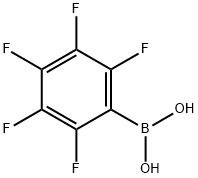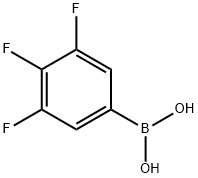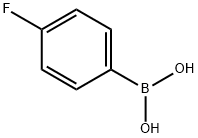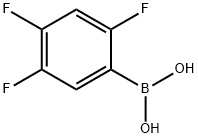2,3,4,5,6-PENTAFLUOROBENZENEBORONIC ACID
- CAS NO.:1582-24-7
- Empirical Formula: C6H2BF5O2
- Molecular Weight: 211.88
- MDL number: MFCD01074663
- EINECS: 627-867-3
- SAFETY DATA SHEET (SDS)
- Update Date: 2024-01-22 16:43:48

What is 2,3,4,5,6-PENTAFLUOROBENZENEBORONIC ACID?
Chemical properties
White solid
The Uses of 2,3,4,5,6-PENTAFLUOROBENZENEBORONIC ACID
2,3,4,5,6-Pentafluorobenzeneboronic acid is utilized in the palladium-catalyzed Suzuki reaction to synthesize several cross-coupled aromatic compounds, for example bis(pentafluorophenyl)-substituted thiophene and selenophene derivatives. It serves as an intermediate and raw material in pharmaceutical and chemical industry. It is also used in dyes and pigments. It can be used to prepare cyclic boronates of bifunctional compounds.
The Uses of 2,3,4,5,6-PENTAFLUOROBENZENEBORONIC ACID
Reactant for:
- Preparation of phenylboronic catechol esters as promising anion receptors for polymer electrolytes
- Preparation of biaryls via palladium-catalyzed homocoupling reaction
- Prepartion of quaternary a,a-heterodiaryl carboxylic esters via rhodium-catalyzed cross-coupling
- C-C cross-coupling reactions
Properties of 2,3,4,5,6-PENTAFLUOROBENZENEBORONIC ACID
| Melting point: | 176-179°C |
| Boiling point: | 244.0±50.0 °C(Predicted) |
| Density | 1.61±0.1 g/cm3(Predicted) |
| storage temp. | Inert atmosphere,Store in freezer, under -20°C |
| solubility | Miscible with alcohols, acetonitrile and dichloromethane. |
| pka | 6.13±0.58(Predicted) |
| form | powder |
| color | White to Almost white |
| Sensitive | Moisture Sensitive |
| BRN | 3033960 |
| InChI | InChI=1S/C6H2BF5O2/c8-2-1(7(13)14)3(9)5(11)6(12)4(2)10/h13-14H |
| CAS DataBase Reference | 1582-24-7(CAS DataBase Reference) |
Safety information for 2,3,4,5,6-PENTAFLUOROBENZENEBORONIC ACID
| Signal word | Warning |
| Pictogram(s) |
 Exclamation Mark Irritant GHS07 |
| GHS Hazard Statements |
H315:Skin corrosion/irritation H319:Serious eye damage/eye irritation H335:Specific target organ toxicity, single exposure;Respiratory tract irritation |
| Precautionary Statement Codes |
P261:Avoid breathing dust/fume/gas/mist/vapours/spray. P304+P340:IF INHALED: Remove victim to fresh air and Keep at rest in a position comfortable for breathing. P305+P351+P338:IF IN EYES: Rinse cautiously with water for several minutes. Remove contact lenses, if present and easy to do. Continuerinsing. P405:Store locked up. |
Computed Descriptors for 2,3,4,5,6-PENTAFLUOROBENZENEBORONIC ACID
| InChIKey | VASOMTXTRMYSKD-UHFFFAOYSA-N |
| SMILES | B(C1=C(F)C(F)=C(F)C(F)=C1F)(O)O |
New Products
(S)-3-Aminobutanenitrile hydrochloride 4-Methylphenylacetic acid N-Boc-D-alaninol N-BOC-D/L-ALANINOL Tert-butyl bis(2-chloroethyl)carbamate 3-Morpholino-1-(4-nitrophenyl)-5,6-dihydropyridin- 2(1H)-one Furan-2,5-Dicarboxylic Acid Tropic acid 1-Bromo-3,5-Di-Tert-Butylbenzene S-2-CHLORO PROPIONIC ACID ETHYL ISOCYANOACETATE 2-Bromo-1,3-Bis(Dimethylamino)Trimethinium Hexafluorophosphate 4-IODO BENZOIC ACID 3-NITRO-2-METHYL ANILINE 1-(2,4-DICHLOROPHENYL) ETHANAMINE (2-Hydroxyphenyl)acetonitrile 4-Bromopyrazole 2-(Cyanocyclohexyl)acetic acid 4-methoxy-3,5-dinitropyridine 1-(4-(aminomethyl)benzyl)urea hydrochloride 2-aminopropyl benzoate hydrochloride diethyl 2-(2-((tertbutoxycarbonyl)amino) ethyl)malonate tert-butyl 4- (ureidomethyl)benzylcarbamate Ethyl-2-chloro((4-methoxyphenyl)hydrazono)acetateRelated products of tetrahydrofuran








You may like
-
 Pentafluorophenylboronic Acid (contains varying amounts of Anhydride) CAS 1582-24-7View Details
Pentafluorophenylboronic Acid (contains varying amounts of Anhydride) CAS 1582-24-7View Details
1582-24-7 -
 2033-24-1 98%View Details
2033-24-1 98%View Details
2033-24-1 -
 1975-50-4 98%View Details
1975-50-4 98%View Details
1975-50-4 -
 2-HYDROXY BENZYL ALCOHOL 98%View Details
2-HYDROXY BENZYL ALCOHOL 98%View Details
90-01-7 -
 2-Chloro-1,3-Bis(Dimethylamino)Trimethinium Hexafluorophosphate 221615-75-4 98%View Details
2-Chloro-1,3-Bis(Dimethylamino)Trimethinium Hexafluorophosphate 221615-75-4 98%View Details
221615-75-4 -
 61397-56-6 CIS BROMO BENZOATE 98%View Details
61397-56-6 CIS BROMO BENZOATE 98%View Details
61397-56-6 -
 14714-50-2 (2-Hydroxyphenyl)acetonitrile 98+View Details
14714-50-2 (2-Hydroxyphenyl)acetonitrile 98+View Details
14714-50-2 -
 118753-70-1 98+View Details
118753-70-1 98+View Details
118753-70-1
Statement: All products displayed on this website are only used for non medical purposes such as industrial applications or scientific research, and cannot be used for clinical diagnosis or treatment of humans or animals. They are not medicinal or edible.